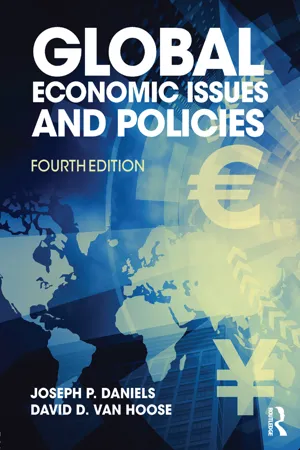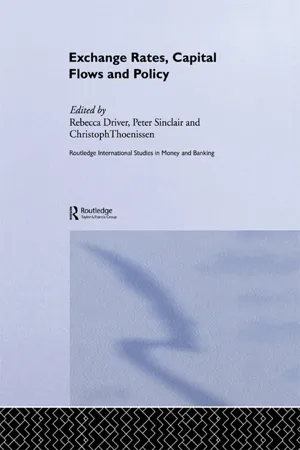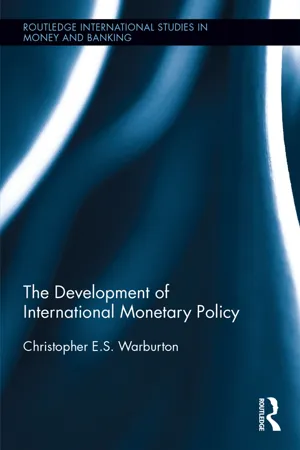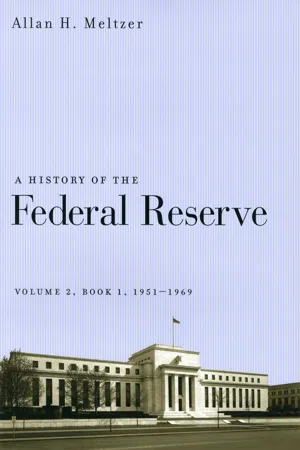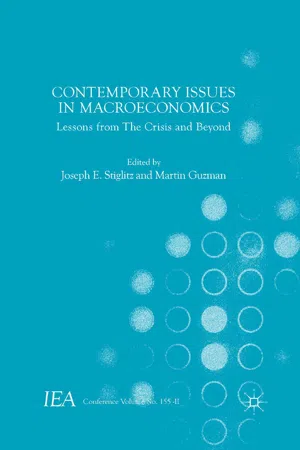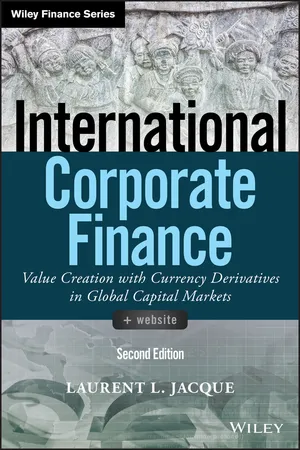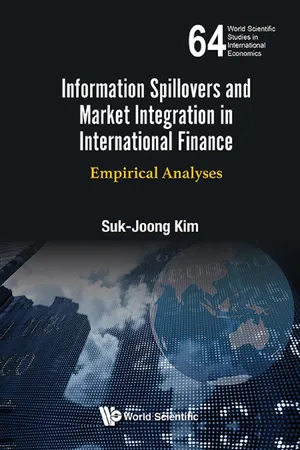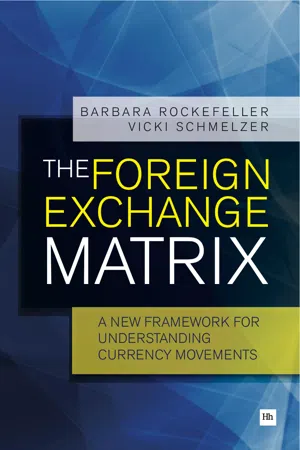Economics
Unsterilized Intervention
Unsterilized intervention refers to a central bank's foreign exchange market activity that does not offset its impact on the domestic money supply. This can lead to changes in the exchange rate and interest rates. It is a tool used by central banks to influence the value of their currency in the foreign exchange market.
Written by Perlego with AI-assistance
Related key terms
10 Key excerpts on "Unsterilized Intervention"
- eBook - ePub
- Joseph P. Daniels, David D. VanHoose(Authors)
- 2017(Publication Date)
- Routledge(Publisher)
Chapter 14 . Before we reach that point, however, in the intervening chapters that follow you will need to learn much more about how policy actions of government finance ministries and central banks influence economic activity.FUNDAMENTAL ISSUE #3
How do central banks intervene in foreign exchange markets?
Central banks typically intervene in the spot market for foreign exchange, using swap transactions primarily to adjust the currency compositions of their portfolios of foreign exchange reserves. If a central bank intervenes to support the current trend in the value of its currency, then it leans with the wind. If it intervenes in an effort to halt or reverse the current trend in the value of its currency, then it leans against the wind. Both central banks and government finance ministries can intervene in foreign exchange markets. Although some nations seek to ensure that their interventions are sterilized, many others do not sterilize interventions fully. Economists are divided about the answer to this question, depending in part on whether one has in mind short-run or long-run effects on interventions. Most economists agree that nonsterilized interventions can have direct, short-run effects on exchange rates by changing relative quantities of currencies in circulation. Some economists also contend that sterilized interventions can alter exchange rates through portfolio balance effects or announcement effects. There is evidence that these latter effects mattered, at least in the short run, during the period of widespread foreign exchange interventions in the 1980s. There also is evidence, however, that even coordinated interventions had relatively small effects, may have added to exchange rate volatility, or may have caused taxpayer losses owing to greater currency risks incurred by governments and central banks. - eBook - ePub
Money, Banking, and Financial Markets
A Modern Introduction to Macroeconomics
- Dale K. Cline, Sandeep Mazumder(Authors)
- 2022(Publication Date)
- Routledge(Publisher)
The term ‘currency sterilization’ refers to the practice of intervening in the foreign exchange markets with the intention of maintaining the value of one currency relative to another, while also attempting to curb growth in the monetary base. Remember from the foreign exchange market diagram developed in the previous chapter that a country cannot change its interest rate without expecting a resulting exchange rate change. Yet, a country that is fixing their exchange rate would like to get hold of as many foreign assets as possible in order to maintain their fixed exchange rate. Sterilization allows them to do this.Typically, intervention takes place when a central bank purchases foreign currency from its commercial bank system, paying for it by issuing new reserves, resulting in an increase in the domestic monetary base. If that central bank wishes to reverse that injection of new base money (i.e. addition to reserves), it must then employ tactics to adjust out the newly issued reserves, thereby sterilizing the change created by the intervention. Let us now see this process a little more precisely by means of an example.Suppose the Chinese central bank has the following simple balance sheet:Assets Liabilities Domestic Assets 4 trillion Currency 2 trillion Reserves 2 trillion where the vast majority of domestic assets held by the central bank are domestic bonds. Notice that the liabilities side—currency plus reserves—is equivalent to the monetary base. Next, suppose there is increasing pressure on China’s currency, such that it would appreciate if the central bank did not intervene. For example, this could be caused by a greater supply of foreign currencies—such as the U.S. dollar—on the market. The issue for China—the country trying to maintain its exchange rate—is that if these foreign currencies are not removed through intervention, they are available for trade on the foreign exchange market. This enlarged pool of foreign currencies makes the yuan more valuable relative to them, which is not what China desires since it raises the prices of their goods that are exported overseas. This thereby makes Chinese goods less competitive, which is the very thing they wish to avoid. - eBook - ePub
- Rebecca Driver, Peter J N Sinclair, Christoph Thoenissen(Authors)
- 2013(Publication Date)
- Routledge(Publisher)
The extent to which a central bank sterilizes the effect of foreign exchange intervention on the monetary base can vary with many factors. Among those are capital mobility, different types and nature of disturbances underlying movements in exchange rate, business cycle, fiscal flexibility, and private agents’ asset demand behavior (Calvo 1991; Frankel 1994; Kletzer and Spiegel 1996; Glick and Hutchison 2000). There is little scope for sterilization as financial markets are increasingly globalized and in turn capital mobility or substitutability between foreign and domestic assets becomes greater and greater. Although sterilized intervention remains feasible to some degree, its effectiveness depends on the way it is implemented. Furthermore, monetary policy will be independent of exchange rate policies only if foreign exchange interventions are completely sterilized in the long run. The fact that the degree of short-term sterilization is high has no significant implications for monetary control, while it can reduce the initial impact of intervention on the monetary base and distribute its effect more smoothly over time.This chapter presents an empirical analysis of the relationship between foreign exchange market intervention and monetary controls in Korea over the managed floating exchange rate period 1981–2001. The study investigates how the Korean monetary authorities intervened in the foreign exchange market in response to exchange rate movements, and the extent to which such exchange rate policies might have influenced the monetary base and money supply or interest rates. The rest of the chapter is organized as follows. Section 2 sets out balance of payments and central bank balance sheet identities as well as monetary policy reaction functions and reviews the theoretical predictions of the possible linkages between foreign exchange interventions, sterilization, and monetary controls. Section 3.1 reviews some stylized facts about movements in the exchange rate of the Korean won against the US dollar, official foreign reserves, and related variables during the period 1981–2001. Section 3.2 and 3.3 present econometric analyses of the behavior of foreign exchange intervention and sterilization respectively. Section 4 - eBook - ePub
- Christopher Warburton(Author)
- 2017(Publication Date)
- Routledge(Publisher)
Table 7.2 . The sample sizes have variations because of the varying number of willing respondents. The number of respondents is much smaller for Asia, relative to Latin America. Based on daily foreign exchange market turnover, two central banks in Emerging Europe intervened more aggressively. However, from 2007 to 2012, the size of interventions seems to be generally irregular.The size of intervention relative to FX market turnover is symptomatic of a central banks’ market power to affect the current exchange rate, and its share in FX reserves as a measure of their potential strength to influence the future exchange rate. As a group, the Emerging Economies seem to have some amount of market power though their collective strength declined after 2007. The Banks of Korea, Poland, and India intervened to stabilise their currencies after the 2007 crisis (Mohanty and Berger 2013: 61–2).Beyond the stabilisation of fixed exchange rates, sterilised interventions (those dealing with disruptive capital flows) are designed to attain external stability rather than domestic or internal stability. Central banks may purchase and sell foreign currencies in a manner that is not intended to alter the domestic monetary conditions, base money supply (money as a medium of exchange and store of value), and implicitly, the short-term interest rate.The manipulation of the value of a currency falls within a broader spectrum of politics, economics, and law. Implicitly, by the connotation of verbiage, the practice of manipulation is designed to gain undue competitive advantage, which may or may not be disruptive. Since the effects of manipulation have implications for fair international trade, one might reasonably presume that the World Trade Organization (WTO) should have authoritative rights to adjudicate the effects of unwarranted currency valuation. Apparently, exchange rates and trade issues are curiously considered to be separate issues for specialised administration. The IMF is responsible for investigating and making a determination that the value of a currency has been manipulated while the WTO is limited to trade issues. This curious anomaly has made it impractical to resolve exchange rate disputes satisfactorily. - Allan H. Meltzer(Author)
- 2010(Publication Date)
- University of Chicago Press(Publisher)
In this, he reflected the almost complete absence of an explanation in the 1961–62 discussions of what Martin and the FOMC expected to achieve by intervention. There are many statements recognizing that currency market intervention could not reduce the payments imbalance. At various times, Martin and his colleagues cited increased productivity, reduced government spending abroad, foreign aid, military assistance, and other real factors as the principal causes of the problem or the sources of potential improvement. And they recognized that currency market intervention was just another type of open market operation. The only advantage was that the swap arrangement delayed a reduction in the gold stock and reduced dollars held by foreigners. The offset was an obligation to repay the borrowed foreign currency in ninety days, with one possible renewal (Later extended). It differed mainly because it gave a temporary stay to gold sales. There is a glaring omission from the 1961–62 discussions. The terms “sterilized” and “Unsterilized Intervention” never appear. In practice, the Federal Reserve sterilized its intervention. It had shifted to an interest rate target some of the time and soon after, most of the time. 157 The special manager withdrew reserves when he sold foreign exchange for dollars. This action increased the market interest rate (and reduced free reserves), inducing the domestic desk to purchase government securities, thereby supplying reserves and reducing the interest rate back to the target. The net effect was to change the mix of assets held by the Federal Reserve and the market. Purchases of foreign exchange shifted the mix in private portfolios also. The market faced smaller exchange risk and greater interest rate risk. Given the large size of the stocks of government securities and foreign assets and the relatively small size of foreign exchange operations, this effect was trivial- eBook - ePub
Contemporary Issues in Macroeconomics
Lessons from The Crisis and Beyond
- Joseph E. Stiglitz, Joseph E. Stiglitz, Kenneth A. Loparo, Joseph E. Stiglitz, Martin Guzman(Authors)
- 2016(Publication Date)
- Palgrave Macmillan(Publisher)
If policymakers do care about the exchange rate, can they do better than the strict IT-cum-floating-exchange-rate regime implies? The answer is yes. Indeed, in this very simple example, there is a clear policy assignment rule: the interest rate should be used to meet the inflation target, while sterilized intervention should be geared to the exchange rate objective. Thus, the policy interest rate would be lowered in the face of negative demand shocks but would not react to capital flow shocks, while intervention would be used to resist appreciation pressures from inflows and depreciation from negative demand shocks.Despite its simplicity, this benchmark model embodies a basic truth: if policymakers have multiple objectives (which they surely do), and if the central bank has multiple instruments (which it probably has), then in general it makes sense to use the full set of available instruments. While it is difficult to argue against this point in the abstract, in our particular context, three objections can be raised. First, that modern EME central banks (like their advanced-economy counterparts) are largely indifferent to the level of the exchange rate provided they are meeting their inflation objective. Second, that central banks do not really have two instruments because sterilized intervention is ineffective. Third, that the flexibility afforded by an active exchange rate policy is not costless because it potentially sends confusing signals about the primacy of the inflation target, undermining its credibility.The first objection – that central banks are largely indifferent to the level of the exchange rate – is addressed in Ostry et al. (2012a), which presents empirical evidence on the degree to which policy settings, including FX intervention, react to the exchange rate. The second objection is taken up in the next section of this chapter. On the third, that is on whether having a second policy objective undermines the credibility of the inflation target, I would argue no - eBook - ePub
International Corporate Finance
Value Creation with Currency Derivatives in Global Capital Markets
- Laurent L. Jacque(Author)
- 2019(Publication Date)
- Wiley(Publisher)
ex post basis from variations in the level of central banks' foreign exchange reserves.- In a system of stabilized exchange rates, the central bank is contractually committed to maintaining the prevailing exchange rate within a narrow, publicly defined band of fluctuations. Clearly, uncertainty about future spot exchange rates is, barring a major devaluation or revaluation, the reason this system is often referred to as a system of “pegged yet adjustable” exchange rates, bounded from the standpoint of market participants.
- Under a system of controlled exchange rates, the central bank supersedes the marketplace by becoming the sole buyer and seller of foreign exchange. The rate at which transactions take place is no longer determined by the interaction of supply and demand forces; rather, it is the end product of bureaucratic decisions. Furthermore, buying and selling rates are not necessarily identical, nor are selling and buying rates uniform across all foreign exchange earnings or payments-generating transactions.
QUESTIONS FOR DISCUSSION
- What is the difference between a “clean” float and a “dirty” float?
- Why do countries intervene in their foreign exchange markets?
- What is the difference between currency convertibility and exchange rate flexibility?
- Explain how central bank intervention allows a country to keep its forex rate at a certain level.
- What is the difference between central bank intervention in the foreign exchange market in the context of floating versus stabilized exchange rates?
- How would you contrast a controlled exchange rate with a stabilized exchange rate?
- What does the explosive growth in China's reserves tell you about the nature of its exchange rate regime?
- The last time the U.S. Federal Reserve Bank intervened in the forex market was in 1995. Would you expect the U.S. foreign exchange reserves to have increased or decreased over the past 18 years?
- eBook - ePub
Information Spillovers and Market Integration in International Finance
Empirical Analyses
- Suk-Joong Kim(Author)
- 2017(Publication Date)
- WSPC(Publisher)
1 The BOJ explains in a document on its website (www.boj.or.jp/en/about/basic/etc/faqkainy.htm) that any Yen funds to be sold on foreign exchange markets are raised by issuing Financing Bills. So it appears that it is sterilizing its interventions. However in numerous official statements, it claims that it aims to ensure domestic liquidity is optimal, and these interventions may be used to help achieve that.2 This is also referred to as order flow in the literature, and detailed discussion on this issue can be found in Evans and Lyons (2002) and Bacchetta and Wincoop (2003).3 This is known as the “hot potato” syndrome (for example, see Lyons, 2001). It occurs when dealers sequentially unload unwanted positions, until eventually a satisfied counterparty is found.4 Admati and Pfleiderer (1988) suggested another possible reason for trading volumes to be informative — transaction costs. However these are surely very low in the Yen/USD foreign exchange market.5 In a survey of 13 OECD central banks, Lecourt and Raymond (2003) reported that 80% of central banks prefer to deal with major banks, thus ensuring high liquidity and visibility. Sometimes they do trade with brokers, to maintain their anonymity, if their interventions might be interpreted as inconsistent with current monetary policy and thus falsely signal a change. Some central banks, such as the Swiss National Bank, always choose to announce their intervention activities. For the rationales of secret and announced interventions, and corresponding empirical evidence, see inter alia Neely (2001), Dominguez (1998), Kim et al. , (2000), and Beine and Bernal (2004).6 - eBook - ePub
National Bureau of Economic Research Monograph
US Foreign-Exchange Operations and Monetary Policy in the Twentieth Century
- Michael D. Bordo, Owen F. Humpage, Anna J. Schwartz(Authors)
- 2015(Publication Date)
- University of Chicago Press(Publisher)
Japan participated, buying nearly $1.7 billion, but Germany remained out of the market. At the 15 November 1994 FOMC meeting, Federal Reserve Bank of Richmond President Broaddus argued against intervention because it must interfere with the Federal Reserve’s monetary-policy independence: As you said, Mr. Chairman, it is now widely agreed that sterilized intervention doesn’t have any sustained impact on exchange rates unless it sends a signal that we are going to follow it up with a monetary policy action. This implies, for me at least, and this is really the heart of the matter, that it is not really possible for the Fed to maintain a truly independent monetary policy for an extended period of time while following the Treasury’s lead on foreign exchange policy. Now, of course, in reality the way I see this is that we have maintained our independence by not making a commitment to follow interventions with monetary policy actions. But that’s not a perfect situation either. (FOMC Transcripts, 15 November 1994, 49) In 1995, the Federal Reserve Bank of Richmond articulated the case against intervention (Broaddus and Goodfriend 1996). 46 Although most of the core arguments were well known to FOMC participants, Richmond’s perspective seemed fresh because the authors developed the exposition more completely and clearly than heretofore had been the case. They focused on the connection between intervention and monetary-policy credibility. Sterilized intervention and the institutions associated with intervention damaged the Federal Reserve’s credibility with respect to price stability, they claimed, because Congress had never statutorily mandated price stability as the Fed’s sole—or even chief—policy goal. The central bank’s credibility with respect to price stability was purely reputation-based. Such credibility is hard to acquire and is inherently fragile - eBook - ePub
The Foreign Exchange Matrix
A new framework for understanding currency movements
- Barbara Rockefeller, Vicki Schmelzer(Authors)
- 2013(Publication Date)
- Harriman House(Publisher)
Conventional wisdom has it that intervention in financial markets is a waste of the taxpayer’s money because it hardly ever has a lasting effect in the absence of a change in interest rates, and sometimes not even then. This was the conclusion of a G7 report on intervention demanded by French President Mitterrand at the June 1982 summit in Versailles and published in April 1983. The committee was chaired by French ministry of finance official Philippe Jurgensen and named for him (the Jurgensen Report), with the key chapter written by the Fed’s international economist Edwin M. Truman.In addressing the subject of intervention 20 years later, Truman wrote[92]“Exchange market intervention has definite limits as a policy instrument. Its effectiveness is uncertain and imprecise, and therefore it is at best a blunt or blunted instrument.” He said, “Intervention is not a separate instrument of policy that can be used regardless of the stance of other economic and financial policies; it is not effective in achieving discrete adjustments in exchange rates, moving them from one level to another and holding them there.” FX intervention is like a drug that works sometimes for reasons we don’t understand and that can be accompanied by unforeseen side effects, “It is dangerous to prescribe the use of intervention except in extreme situations, and it is certainly not recommended for everyday use.”The Jurgensen Report has been added to but its conclusions have not changed since 1983, including a report by the Bank for International Settlements in December 2004 that was published as a set of essays by economists from the BIS and several central banks[93]. Since then, academics have built on the intervention literature with studies of interventions by Mexico, Argentina, South Korea, Thailand, Indonesia – and, of course, China.Is it correct to lump together intervention in fixed or managed-float currencies with intervention in floating currencies? Yes, because the motivation is the same – to obtain or restore a competitive advantage without changing the monetary and fiscal policies that contributed to the currency crisis in the first place.In addition, intervention is triggered by perception of disorderly or disruptive FX market conditions that contaminate other markets, especially stock markets. The intervention by the Hong Kong Monetary Authority in the stock market, during the 1997-98 Asian crisis, was designed specifically to fight back against speculative pressure against the Hong Kong dollar, which is fixed against the US dollar. We might even say that a key motivation in many instances of FX intervention is to prevent stock market slides, since currency devaluation tends to drive away foreign equity market investors. In the case of Japan, everything is upside down – it’s a rise in the yen that harms the stock index, since stocks are dominated by exporters.
Index pages curate the most relevant extracts from our library of academic textbooks. They’ve been created using an in-house natural language model (NLM), each adding context and meaning to key research topics.
